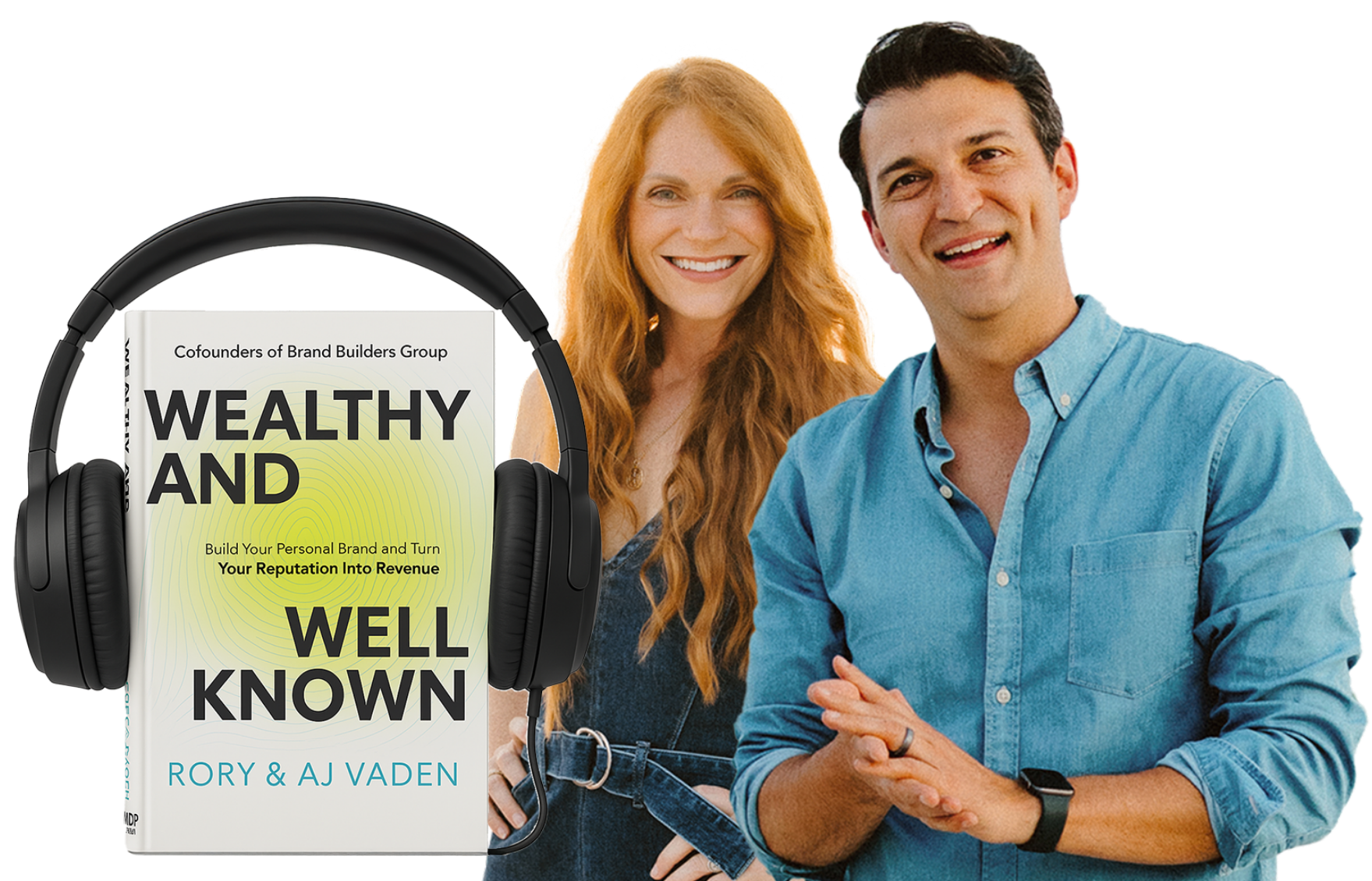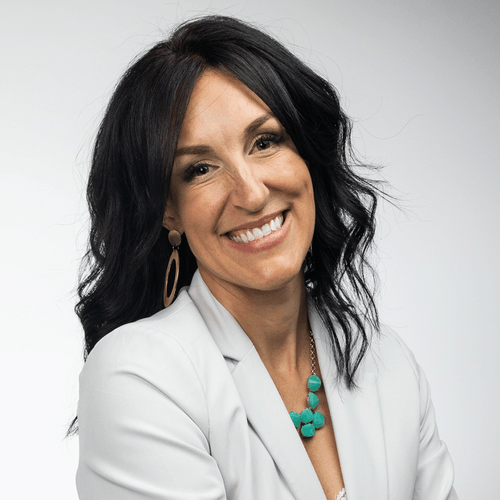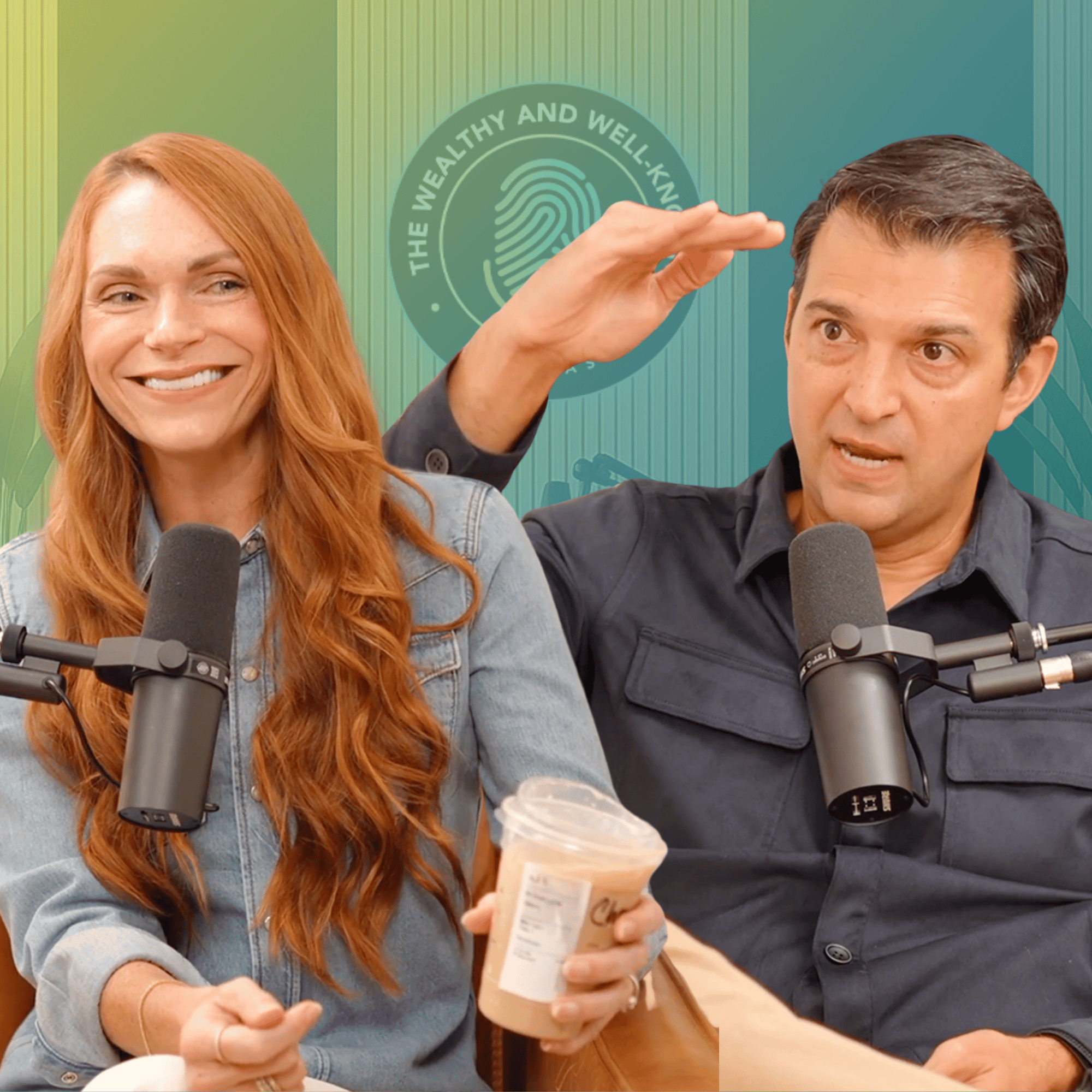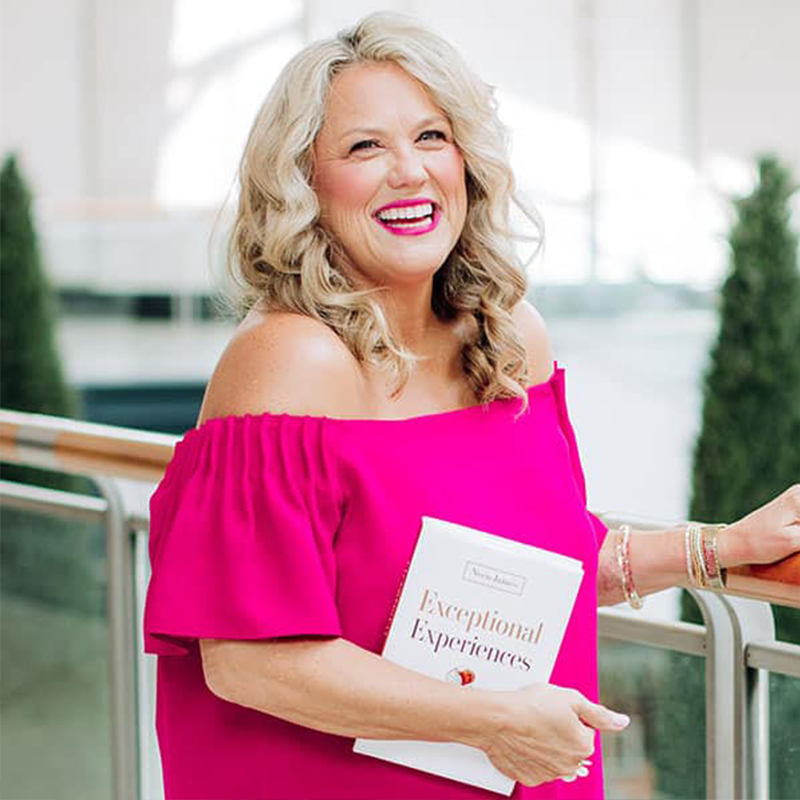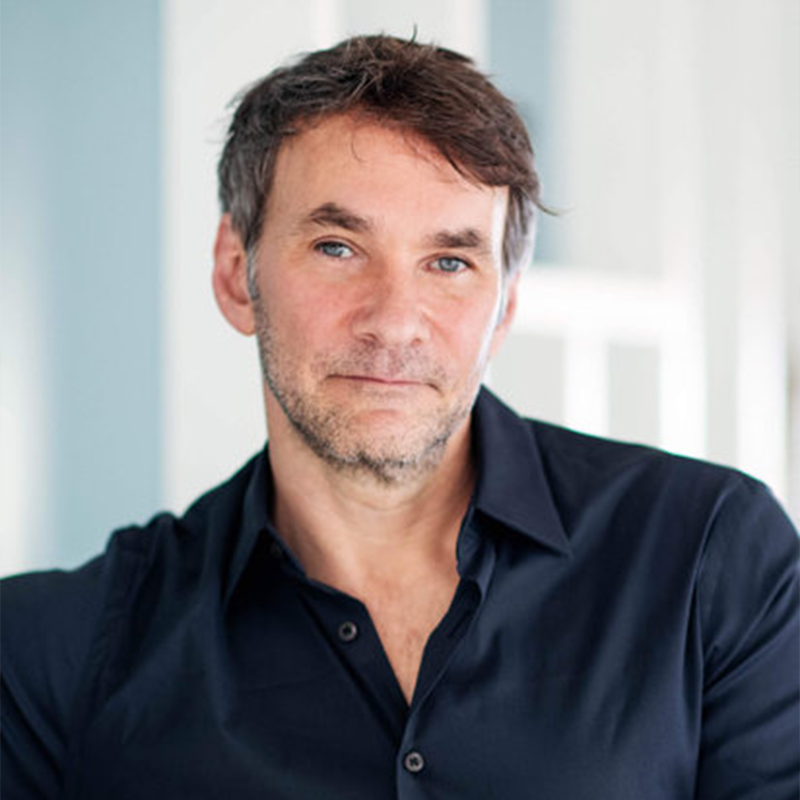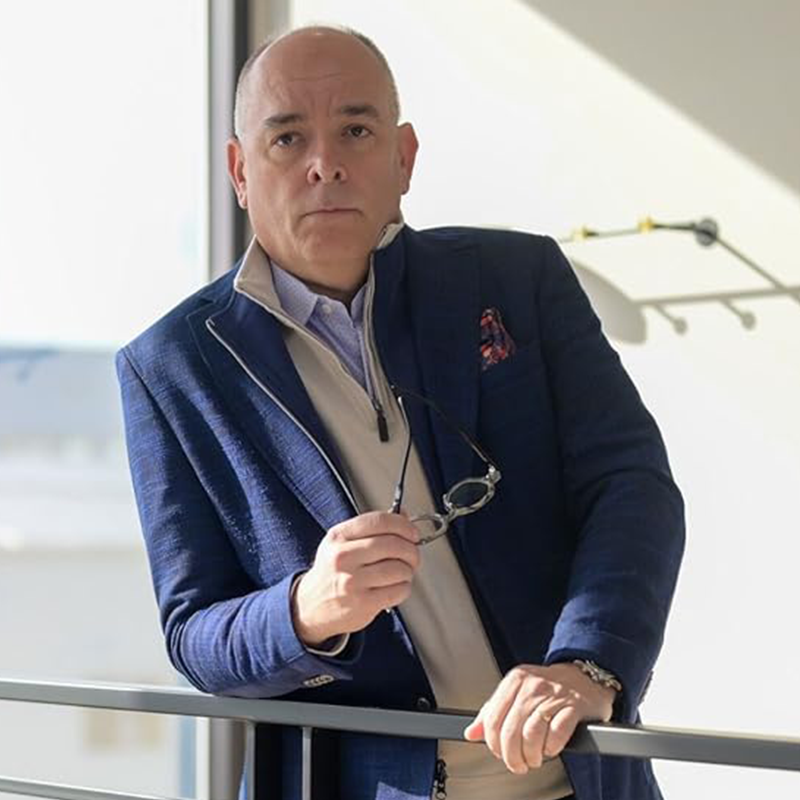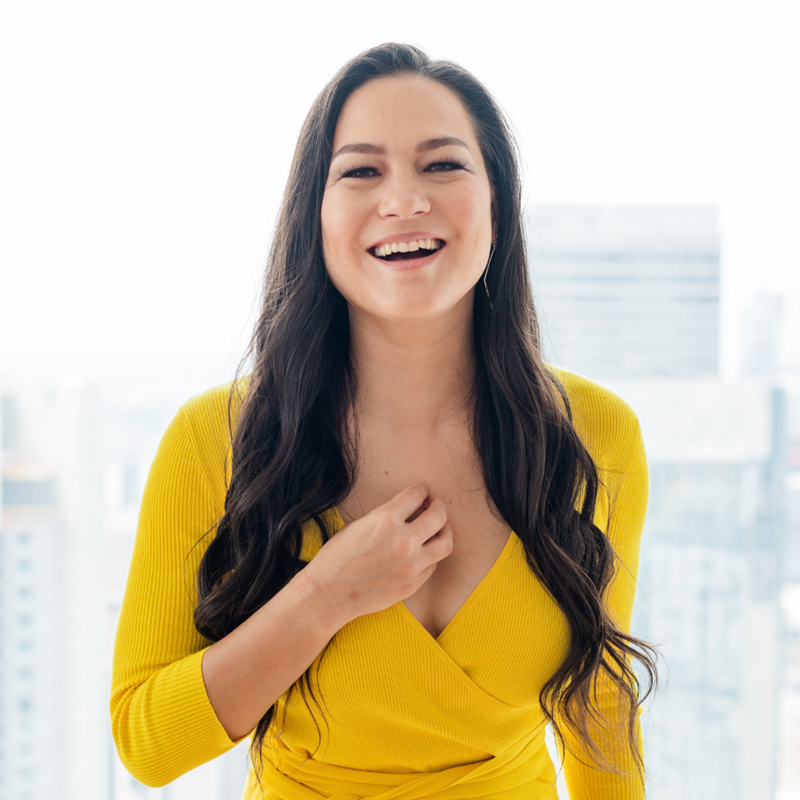AJV (00:02):
Hi everybody, and welcome to another episode on the Influential Personal Brand podcast AJ Vaden here, and I am with a very good friend of mine, Amanda Moriuchi. And today is always exciting to me whenever I get to do podcast interviews, but then when you get to do them with people that you actually really know personally and you get to share their business and their expertise and their brilliance just makes it extra fun. And so before I formally introduce Amanda, I want to tell you why you need to stick around for this episode. So here’s why you wanna listen to this episode. One, the main reason I have invited Amanda on to our podcast is because of the growing number of questions that our community and our listeners like you ask us all the time around, do I need an app? And if I do, how do I know when I am ready to get an app?
AJV (00:59):
And Amanda is going to answer those two question questions very specifically with real tangible data around why you should or why you shouldn’t, when you should, and what that process looks like. So that’s the first reason. The second reason is that there is this growing trend in the world called mobile apps, right? And there is a lot of things behind the scenes that most of us don’t realize when it comes to building, launching, growing, or even potentially monetizing an app. And so we’re gonna talk about some of that behind the scenes work and really what that means for the everyday entrepreneur, small business owner, coach, consultant, speaker, and what that world is gonna look like in the next five 10, so forth years. And then the third thing that you’re gonna learn, and this is also selfishly, is if you are ready for an app, what does that process look like?
AJV (01:55):
Like, does it really have to cost hundreds of thousands or millions of dollars and does it have to take years? And we’re gonna find the answers to that too. So how further ado, let’s get right into it. So I’m gonna give you a little formal bio on Amanda, and then we’ll then we’ll jump in. And the rest of this will be super casual, but Amanda is the CEO of App Ventures, which is an award win, the inter international custom tech company. They have won lots of awards. And I actually had one, one of Amanda’s clients on our podcast just a little while ago called, the company is called Keep With. And Amanda’s team is the one who actually developed and brought that idea to life and app form. So it’s so cool to not only get to know you, but to see your business actually bring things to fruition and products and services that I actually really love and enjoy.
AJV (02:49):
But I will say, I will tell you also, she has developed and led hundreds of top tier software experts to launch over 1000 apps, which is amazing. These apps are averaging a three times return on investment she has or not to divulge your many years of experience, but more than 20 years of experience working with startups, fortune 500 government and non-profits. But I tell you, if you’re not watching this, Amanda does not look like she has been in business for more than 20 years. So, , with all that said, Amanda, welcome to the show.
AM (03:25):
Thank you so much. It’s good to see you, aj.
AJV (03:27):
Oh my gosh, I’m so excited about this. And before we get into the nitty gritty details of building an app and what that process takes, I want people to get to know you a little bit and how you got into this business. But right before we do that, to kind of give people a preview of what to expect for the rest of this interview, can you just give us some very quick highlighted data, trends, insights around what this growing world of apps looks like and where you see it heading?
AM (04:00):
Ugh, I love this question. Yeah, so the biggest trend that I’m watching right now that really I think a lot of your clients and listeners are gonna care about is the shifts that kind of the larger social media companies are taking where they’re starting to lock down some of the most valuable elements of their platform. So for example, the most simple example I can share is you can no longer embed a private Facebook group into your app. And really Facebook knows that they know that people really are starting to build their own private communities mm-hmm. , and that’s where the value is. And they’re gonna wanna hang onto that. And so as I’ve been working with our clients, I want, I want them to look ahead just a few years down the line and consider how are you going to engage your audience or serve your customers if a platforms like Facebook or Twitter or, I mean, Twitter’s a big one, obviously it’s been in the news for a lot of reasons recently and Instagram, what if they start changing their algorithms, changing their rules starting to lock down their access? How are you as a thought leader, as a community leader, as somebody who’s serving your clients? How are you gonna protect your customer experience? And I’m starting to see some of these changes accelerate, and it’s on the one hand exciting, but on the other hand, something that’s giving a lot of our clients some urgency to really plan ahead.
AJV (05:39):
Yeah, so that’s a really good point because we have a private Facebook group at Brain Builders Group, but we have been urgently trying to figure out what is our long term? And for us, long term is like the next, in the next 12 to 24 months, what does that look like? Because not only do we know that that’s not a long term strategy to build our community on somebody else’s platform and that should be no one’s strategy to be honest. But one of the things that we are also seeing is we’re we’re experiencing a growing number of people who don’t wanna be a part of certain platforms.
AM (06:12):
And I’m that right. I’ve, I love you guys. I’ve been working with you guys for a couple of years now, and I’ve never been a part of Facebook as at like, when I’ve been with Brand Builders Group. I was a part of Facebook when I was a college kid when it first started forever . But you know, I think another that ties into the second big trend is really being mindful of how you’re using your customer data, right? Mm-Hmm. . So a lot of the larger platforms, how they make money is by mining data from the users. And that doesn’t serve your customers at the end of the day. In fact, it kind of puts them at risk. And so we’ve been working with our clients on thoughtful ways to gather data in a way that serves your customers instead of just taking, taking, taking, right?
AM (07:06):
That’s, and you also really need to keep an eye on some of the legal changes and regulation changes that are headed our way. I, I know everyone knows about GDPR in Europe similar laws have already passed in California, and you’re gonna start seeing those laws slowly spread across the country. And you have to be very careful as you’re planning ahead for some of that kind of stuff too. So really, I think end users are demanding more demanding more from the apps that they work with demanding more privacy, demanding more intimacy, demanding more connection, and it’s a really exciting time to be developing tech for good that really is in service to end users rather than just taking,
AJV (07:56):
I love that It’s building technology for good. Yeah, I love that. It’s like with any tool, it can be used for good or for harm. And it’s like, how do we just do it that’s got this mutual benefit for the end user. So good. Y’all, this is why you need to stick around. We’re gonna get into the nitty grits of this, but I, I am super curious, like, how did you get into this world, this business? Like, give us just a little bit of background of why apps we could have done so many different things in technology. I know you’re wicked smart, but why this
AM (08:32):
Totally on accident, to be honest with you, I, I fell into technology at an early part of my career and I think truthfully, that’s what made me successful, right? So I think a lot of times where people get frustrated with technology is you have a business person speaking to a technology engineer and they just speak past each other, right? And when I first joined the industry, I didn’t know anything about technology that wasn’t my, that wasn’t my expertise. And so I found the smartest people in my organization and I made them sit down with me and explain everything. And so I think with that, that gave me the ability to blend business and technology and make sense out of something that is really can be overwhelming if you don’t understand the nuance. And so I think I built my career on being that bridge between what a business leader wants as an outcome and what is possible from a development perspective.
AM (09:38):
And I’ve come to realize that’s kind of a rare trait to almost act as a translator between the two ends of the business. And it’s been incredibly rewarding. So the reason why I stayed was because I believe in my core that technology has the ability to level the playing field. It grants access to vulnerable populations, to affluent populations, and everything in between. It really breaks down the barriers between location, right? So, I mean, I have to say a j I found you guys through technology. Mm-Hmm. . I mean, Lori was giving a presentation a few years ago at a conference that was on the East coast that I attended from Denver. And you know, I think that’s been the, the thing that’s kept me so passionately involved in the industry is just that magic of technology to bring together ideas and to make something that wasn’t possible yesterday, possible today. And especially now more than ever connecting communities of people that are bound by a single passion or a single interest and just infusing some positivity into the industry. And it’s been so rewarding.
AJV (11:00):
You know, it’s so interesting that you say this. I’ve I actually made a post about this book that I’m reading called Find Your People by Jenny Allen. And I love Jenny Allen and I love this book specifically cuz it talks about how we’re in unprecedented times in America at least of a lack of community. And what an interesting thing with more technology availability and more interfaces and more this, that as a country we’re at an all time high of people who suffer from depression, anxiety addiction, and most of that stemming from an internal feeling of loneliness. And this entire book talks about loneliness is the real epidemic that we’re experiencing here in America. And then all these other things are the byproduct. And so I love what you say cuz it’s like, again, it’s like using technology for good and you know, we are most interested in our technology for communal purposes.
AJV (12:03):
It’s how do we stay in touch with people? How do we connect, how do we stay present and available when we are hundreds or sometimes thousands of miles apart? And I really do at some point during this interview wanna talk about the power of using apps specifically for community because as we are experiencing on the social media realms of today, and as we will continue you cannot build your audience on a borrowed platform. And that is Facebook, Instagram, LinkedIn, Twitter. That’s what they all are. And so if you don’t have a plan of building an audience that you own then at, at some point you’re at the mercy of big tech companies and big investments, bankers deciding how you’re gonna engage with the people that you have built a following with. And so I love what you’re saying about just doing it for the purpose of community and doing it for good.
AJV (12:55):
Cuz I think that’s a really critical part of where business is heading and people are building these communities that are the source of major business and revenue. Back to this like, you know, customer loyalty is like people stay with people more than they stay with companies. So how do we do more of that? So, okay, so getting into this app conversation, which I love and I’m fascinated by because I feel like I get, I feel like going into the app store is like me going into like TJ Max, oh my gosh, I’m so overwhelmed. I go walk in and I’m like, there’s like too much here. I don’t know what to do. I don’t know which one. It’s like, I’m like doing it by customer ratings and it’s like, it’s so overwhelming to me. It’s like, I won’t even consider an app until like five or six people have said, you have to have this. And there’s just like, it’s so overwhelming and there’s so many of them. And so there’s my question with them being so many, how do you create something that actually does anything for good? And I guess my real, my real first question is, do you need an app?
AM (14:04):
Yes and no , so lemme say this, I couple of things on the loneliness as an epidemic. My, my belief on that is that we were sold a a bill of goods, right? Like we were said, we were sold. Facebook is a place for community, right? It’s not, it’s the town square, right? So any, any introvert would tell you, and I I’m a closet introvert, any introvert would tell you you don’t go to the Town Square or an example would be like a large concert hall to be filled up and to form an intimate connection. That’s not where you go. Like you can go meet people in the town square, you can go meet people in the concert hall, but you build connection outside of that. And, and I think we really need to be clear on what do you mean by community? Do you mean town square or do you mean intimate connection?
AM (15:06):
And somehow those two buckets have gotten muddled, right? And I think, I think that’s a crusade that I’m up against right now is like, great build your town square, right? Or build your audience in your town square, but you bring them into your community and you protect them. And that’s when you’d want an app, right? So we say, look, work with brand builders group, build your following, build your audience. And once you reach a certain kind of magic number in terms of like a certain number of engaged followers, you need to bring them to a place where they’re sheltered within your community. And then they start to form intimate bonds. And that’s the magic of an app, right? So let’s go back to the TJ Max example. I get also super overwhelmed by TJ Max because like the racks are just overwhelming. I can’t even remember that You have to like, like comb through all of the different types of brands and sizes and product types and all of that.
AM (16:17):
If you could imagine going into TJ Max and knowing, okay, it’s, it’s a Thanksgiving, right? It’s, I call it the high holiday time, right? It’s Halloween, Thanksgiving, Christmas, like the best time of year to decorate, right? And so in that time of year, if I go into TJ Max, and I know I’m looking for a particular brand of a decor item. Ray Dunn is really well known in TJ Max, right? I don’t have to spend as much time as much of my attention, as much of my focus combing through all these different products if I know a very particular brand that I’m going for. Another example would be like in clothing and Under Armor, I know that I’m looking for that brand so I can go to that rack and more quickly sift through the noise, so to speak, and find the product that I’m looking for.
AM (17:11):
And that’s applying that analogy to technology, right? So one of my biggest gripes is if I’m looking for a particular type of content, not, not that different than shopping for a particular product. Let’s say I need some business inspiration, right? I’ve hit a plateau in my role. I’m tired, I’m burned out, I wanna go find some inspiration. The first thing I do is I go to Instagram and I look at all the people that I’m following and let’s pretend AJ posts something really inspiring that I haven’t seen before. And I’m like, who is this AJ Vaden? And then I start getting to know you, right? Testing you out a little bit. And then I’m like, I love what she has to say. What else does she have? And then I come upon a post where you’re like, Hey, I’ve just launched an app. All of my thoughts, my podcast, my books, any products that I’m selling, the community that I’ve built, it’s all here in this place.
AM (18:17):
Essentially come to my digital store. So we find that customers that rely on simply people finding you through the app store, they don’t succeed. Yeah. Because the app store is not going to elevate your app. The app store, I’ll, I’ll save a lot of my commentary on the challenges of posting something in an app store. That’s not the way to market your app. The way to market your app is by building an audience first. Having that foundation first and then having a plan to convert them to app users, right? You build your audience first and then you protect your community. But you can’t, you can’t protect a community that you don’t have, right? Yeah.
AJV (19:02):
So it’s such a good reminder to anyone who’s listening. Cause I think we all get tempted of what’s the newest, bright and shiny thing? What is everyone else doing? And it, it’s a really core part of mine. And my husband Rory’s philosophies and a part of Brain Builders group, it’s like there is a time and a place for all the things. And, and, and this example, an app is no different than a business model, right? It’s like you gotta have people to buy your products and services if you’re ever gonna make any money, right? And so there are two things that you said I think are really interesting and really important. And you said there’s this magic number, right? Like if you have this many followers and so care to give us any ranges of like what that ma magic number might be be Yeah.
AM (19:47):
Yeah. So our most successful clients come to us with an engaged audience of 10, at least 10,000 followers, right? And that can be across channels, right? Because you could, you can have 10,000 followers on LinkedIn. You can have 10,000 followers on Instagram. They can be divided amongst those right? Now, here’s why. So there are basically three main revenue streams in an app. The first one is pretty simple, paid subscriptions, right? And the second is advertising where essentially you can set up advertising space within your app and you can work on on a content mediation platform. They’ll fill in that ad space for you. And then the third would be like sponsors or strategic partners or people that want to have their logo in front of your community. Those are your three podcasts. Yeah.
AJV (20:43):
Podcast, okay.
AM (20:44):
Exactly. Exactly. And so let’s do some rough math here. If you can convert half of your 10,000 audience members to paid subscribers, and let’s just say you’re charging $20 a month for access to your app, and that would be content. The content that you’re producing, that would be the community that you’ve built around your content. I I describe that as like a digital country club. So this is an exclusive group of people that are building relationships around your core truth, right? So or as brand builders talks about your through line, right? And these are engaged people that are helping you along your path and building community, again, around your core truth. And then you might be selling some products, right? So my most successful clients host their podcast on the app. They will put digital versions of their book on the app. If they’re selling any physical products, you can sell a physical book if you want. You can sell shirts or mugs or whatever it is that you’re selling to further your brand. And let’s say that you have 5,000 users charging $20 a month low cost for high, high value, when you launch on launch day, you’re making a hundred thousand dollars in monthly revenue. Mm-Hmm. , I mean that’s, that’s game changing for a lot of these thought leaders that I see in the market. And yeah,
AJV (22:18):
So this, so you said something really quickly cuz I’m curious how many people, and this could be just like a wildly guesstimated number here, but how many people do you think are charging for their ad versus just getting it for free?
AM (22:33):
So,
AJV (22:34):
Or should there be some versions?
AM (22:36):
It’s, it, you could do, you could do a freemium version where you’re exposed to ads now. Okay, so let’s talk about ad revenue because a lot of people kind of have the misconception that ad revenue is based simply on number of downloads and that’s not the case. So you need to have a number of active users. I guess that’s where a number of downloads make sense. But if some, somebody downloads your app and never opens it, you’re not making money off of that user, right? So it needs to be somebody that’s in your app and stays within your app for a longer period of time. And so that’s why you need a little bit more. So you need to convert about 80% of your engaged audience to deliver revenue substantial enough revenue on the freemium side, although I spend most of my time convincing my customers to have a paid application. And the reason why is one of my sales managers way long time ago said, Amanda, people value what they pay for mm-hmm
AJV (23:42):
.
AM (23:43):
And so I would say this back to our most successful apps. They come down to, there are two paths, but the the biggest one that we’re kind of talking about right now is you form a core truth. What are you here for? What breaks your heart? As brand builders taught me, what are you here to solve? That’s your core truth. You build content around your core truth and then you build a community that’s engaged around that content. That’s incredible. Regular high value content and connections that you’re providing your users. And I would say any country club charges for admission, any movie theater charges for admission, the people that you want in your digital community must be paying because they value what they pay for. And that’s what I’ve seen with our most successful clients in this type of a scenario where you have your core truth, your content, and your community.
AJV (24:45):
Okay, so I have like 14 questions right now, . So, cause I think this is really fascinating specifically for our audience who is wildly full of speakers, authors, coaches, trainers, consultants experts, right? So it’s like you could be a more a mortgage lending expert or a physician either way. It’s like, but they are, they’re very convicted in building an audience and, and doing something good with that audience. And so just think this is a really fascinating concept. So this whole idea of having an app for your community, which I personally love, and it’s something. So I think it’s just something that’s really important as we proceed into the future with the uncertainty of the platforms and the constantly changing algorithm and new rules and laws and regulations and the fact that most of your audience already isn’t seeing your content. So just a little bit about how do you build something that you actually get to influence and you actually do get to build connection with. And so going, going down that rabbit hole, here are some of the questions I have. So I think I hear you saying a paid app is kind of the way to go. And I think that’s really wise and I actually really appreciate that. And I I’m asking myself, is there a price point that you see for a paid app for somebody who is building their audience and building a community with an app that is an appropriate price point? Any ranges? Like what’s too much little,
AM (26:14):
No. So I would say this, it, you’re, this is not a cop out. I, I apologize. It depends, right? So looking at like category types, so like fitness for example, most of the fitness apps that we’re seeing out on the marketplace are charging anywhere between 20 to $40 a month, right? But hear me out on this on the fitness side, like you’re, you’re basically getting a digital personal trainer for $40 a month and tell me where you can go in any gym across the country and get that kind of dedicated high level personalized attention. You, you can’t, right? So I think that’s kind of the, the value there. Now let’s, let’s apply, let’s say like brand builders group and what you and Rory have to share, right? You guys are high level business strategists. You guys are coaches, you guys come in and you work directly with an entrepreneur to help them build up your business.
AM (27:20):
Okay? Where else are you gonna find that in the marketplace? Person to person? And if you’re, if you’re able, I would say charge 50 to $75 a month because you’re getting people that are engaged and really wanna, wanna level up their business. And that’s just for the app aj. That’s not for like access to events, that’s not access to products, that’s not access to one-on-one coaching, right? All it is is an entrance fee into the sanctuary that you’re building for your community, right? And so I would say most of our clients start out charging $20 a month just because it’s an even easy number for people to absorb. You’re not gonna get pushback. And then a lot of our clients will engage in ab testing on pricing when we work with our clients, we’ll kind of do a competitive review of what’s in the marketplace and what you can charge. The problem is, a lot of our clients right now that are thought leaders in this space that are kind of building what we are calling like the digital country clubs, they’re at the forefront. And so when you’re at the forefront, you have to guess and when you’re guessing, you have to compare, okay, how much am I charging versus the value I’m providing? And if that gap is big enough, you’ll start seeing volume that comes in much more quickly than, than if you’re kind of just throwing something at the wall and seeing what sticks.
AJV (28:49):
I love that. So, and, and I agree, I do think there is so much value in having gated content and building this gated community. And so that leads me to my next question. And you know, both, for me and everyone listening, I figured if I have these questions, so do you remember listening? So then it’s what content do you save just for your app versus what content do you continue to put out there on the different platforms in order to attract people into the app? And so have you seen any successful ratios of what type of content should be gated that people are paying for? And then you mentioned some people even put their podcast on there. So are they no longer on iTunes and Spotify? And are they only in the app? And how does that really work? So
AM (29:41):
Yeah, great question. So let, let’s talk about the podcast piece first. So I would say if you have a podcast, still put it out on iTunes, still put it out on Spotify because what you’re doing is you’re fishing, right? Like you’re putting lines in the water to attract more people from the town square into your protected community, right? That’s the purpose of having an Instagram feed, of having a podcast, of having a blog, having an email newsletter, all of these things, the purpose of those activities or putting lines in the water into the town square fishing for people to join your protected community. So a lot of times my frustration is I actually follow a, a bvg client on Apple Podcasts and I get super frustrated because Apple is now changing how they set up their podcasts without your per or oversight. They’ll put advertisements into your podcast. Yeah. And you’ll start seeing that with podcasts and iBooks even. They’re inserting ads. And so you’re starting to see the evolution of Apple from a product company to a media company, right?
AJV (30:58):
I have noticed that too. And many people who we know who have very, very, very big podcasts they are quickly going, what? Like, exactly. You can’t have ads on my show without even asking me. But yet they can,
AM (31:15):
They can because it’s rented space, right? So I would say in the podcast example, you put the, that podcast out on iTunes, Spotify, whatever for Phish purposes, you bring that also into your app as, and you can put it in front of the paywall or behind the paywall. That that’s, that’s kind of your prerogative. But what the thing is is now I know if I wanna hear from aj, I’m gonna go to AJ’s app mm-hmm. because I’m an engaged user, right? And so it’s kind of like you’re fishing by putting your podcast out on iTunes, and then maybe what you’re doing by putting your podcast in front of the paywall with some ads so you can still make advertiser revenue that advertisers you pick not that someone else has picked for you. You can put the podcast with ads in front of the paywall to reel in your customer and qualify them to make sure they’re worthy to be a part of your protected community. And the minute they start paying for the app, then they have the podcast behind the paywall without ads, right? So the idea is leveraging your content to validate the fit for the person to be in your community and the community is where the real value is. Okay. Does that make sense?
AJV (32:40):
Absolutely. Yeah. No, I think, again, back to the quickly changing landscape that we’re all living in, where now Apple is deciding, well, we’re gonna decide what ads we put on your podcasts and even YouTube. It’s like, I could put an ad on your podcast today to advertise my podcast if I wanted to, right? And I think there’s just a lot of that of going, man, it’s like I’m trying to create an experience for my audience and Exactly. Advertisers and big media companies are kind of getting in the way of that. So then, so then the question is about how much content do you reserve for the app versus what you’re just putting out there on social media?
AM (33:21):
Yep. So the biggest way I encourage our clients to delineate is the content you put out on social media or in front of the paywall. Those should be an invitation, right? So it’s free because it’s an invitation. The content that goes behind the paywall is the instruction on execution, right? So the invitation might be a sample, might be the first bite or two, but then the real getting down to the nuts and bolts of executing to solve the problem that you’re working against that sits behind the paywall. And so what happens is, if you have a, and actually the beautiful thing is you don’t really need to have a ton of content that you’re consistently refreshing that’s behind the paywall. Because what happens is people will go through that content that’s behind the paywall and through that build connections with the community that have already been around and been doing the execution.
AM (34:25):
And so people will come for the content and stay for the community, right? So what it does is it takes a little bit of weight off of the content creators. The hardest stuff is teaching on execution, right? That takes a lot of thought planning production time, production cost what you can do, once you’ve established that behind the paywall, then it alleviates the pressure. So you can focus more on generating the fresh content that is acting as the invitation, right? Almost like the advertisements to the town square. And the reason why you need to have fresh content constantly is because you as content creators are consistently diluted mm-hmm. on the town square, right? And so you have to keep up with that pace to continue to invite people in and bring people in. That’s, that’s marketing. Whereas the stuff behind the paywall is building and keeping your engaged community.
AJV (35:27):
So then this leads me to my next question cause I agree with all of that. Which is what’s the likelihood of, I don’t know, know even like, even in the app store? So I don’t know if this is true, but I was told this here recently and it stuck with me that Apple takes about 30% of revenue for every app sold. That’s about right.
AM (35:51):
, they, well, okay, so up to a million they’ll take 10%. So nice, generous bit there over 10, over a million in revenue, they take 30%. But something important to think about here is they take 30% of digital content. So if you’re selling coaching separately, that’s not digital content and therefore not subject to the 30% commission. If you’re selling physical products, you’re not, you’re not subject to that 30%. So app it, what we’ll do is we’ll work with our customers and get creative with ways to protect your revenue and shield some of that from the Apple tax. So we
AJV (36:36):
Call it, okay, the Apple tax, that’s good, but it’s like, basically if you’re under a million in annual revenue, they’re taking 10% of gross revenue. So just build that into the budget. And so I guess my question is, which I did not realize that, so I think that was really important and I came up in a conversation here lately and then my, so my question is like, what, what is the likelihood that Apple, just like all of these other platforms, as Apple is changing this with the podcast, start doing this own thing in the app store where they’re going, well now I’m gonna decide how things are done, because it too is a little bit of rented real estate in terms of, you know, the marketplace, the grocery store of sorts, so
AM (37:15):
Exactly costs
AJV (37:16):
Around that.
AM (37:16):
Yeah, so we we’re watching a lot of what’s happening with Apple and Google, especially as it relates to the app marketplaces. I, I don’t see Apple increasing commission, nor do I see them trying to make any large changes or dominate app owners or developers for a couple of reasons. First of all, they got in deep trouble with the government on how they were managing a lot of these commissions and what they were doing. And we saw Apple make a pretty abrupt change in their policies from there. The other thing is for as challenging as Apple can be, they really do love their developer community. And you have to remember, they are motivated to keep developers coming back and app owners coming back because that’s a big part of their revenue. And so this is why you’ll see like app, it was a lot, or Apple was a lot of their major updates.
AM (38:20):
They’re slowing down the impact that it has to developers because they wanna keep their developers happy. They have to, it’s a big part of their business. The one risk I would say is it’s really important for app owners to be aware of Apple’s guidelines because they do change. So one example, I’m sure any user who has an app remembers when you’d have to go through an app update and you’d have to click Ask App not to track that was a guideline change from Apple that every app owner was required to add that button back to the user. And really that’s in response to user demand on privacy and shifting laws. So building an app is no different than owning a storefront, right? Laws change, customer preferences change taxes change, revenues change. And I think that’s all the more reason to want to have your own app to give you the control to pivot in a way that works best for you.
AJV (39:22):
That’s good. All right. Well I have, we just have like five more minutes and I’ve got like two questions here I think that are really important. So this whole kind of concept, or you’ve got 10,000 plus, you know, online followers and that’s growing, then this is kind of like, okay, now let’s talk about like, should you have one maybe. So, and then give us just some high level behind the scenes, what’s that process look like? How much does it cost emotionally prepare everyone listening of real numbers, real timelines? What does it look like to have an app?
AM (39:53):
Oh my gosh, this is the hardest part of the process. Shopping for an app makes TJ Max look like a day at this spa. It’s so I, you know, I actually really empathize and I have a high level of respect for all of our clients because building custom software is not an easy thing to find the right person. It’s, it’s really hard actually. And the reason why is because you have developers from all over the world, right? And they have different salary needs. So a developer in Pakistan is going to charge a much different hourly rate than a developer in the Bay Area in California, even if they have the same level of experience and expertise. And so I think that element and also the creative element. So how an engineer would approach a, an app idea or a technical problem, it’s up to whatever’s in the mind of the engineer.
AM (40:53):
And so one engineer may think that a particular app would take 10,000 hours to build, whereas another developer would think it’s only 2000 hours. And so I think it’s those elements of very wildly varying rates and wildly varying ideas on how to tackle a problem. And that’s where, for a single project you could get a quote from anywhere from $10,000 to as high as a million. And in fact, APPT did recently we did a competitive study a a local against our local competitors and nationwide. And it blew me away. We had detailed features like, this is what we want. And we were getting quote ranges that same whip from $10,000 to a million dollars and app it. We tend to kind of come in like mid-level because we’re a hybrid. So it’s, it’s crazy. It’s really hard. And so, oh gosh, I could spend, you
AJV (42:00):
Make a decision based on, I mean, cuz I imagine most people make a decision based on, well, if I got 10,000, a million, 10,000 sounds a lot better. So, but then it’s like, what at what cost are you paying that, you know, fee? So it was like, how do you even make a decision in those types of environments? Yeah.
AM (42:19):
So I, you know what aj I might have to give you a blog on how to vet vendors. Like we had a list of questions that you should ask every single vendor to make sure that they’re a fit for your project because price is a, like, it’s, it varies so wildly that it’s not, it can’t be a deciding factor, right? Because even if you go purely offshore with a very low cost developer, so that $10,000 example, what you’re missing is cultural context. Mm-Hmm. , right? So you have to respect that offshore development or developers, they build community so much differently than we do in the us And that’s not a good or a bad thing. It just is what it is. Yeah. Right? And if you are looking to build community, you need to work with somebody that understands how you’ve built your community and how you want it to be built.
AM (43:17):
And that in and of itself, I mean, I would say about 40% of our business comes from entrepreneurs who tried to take the cheap route and have ended up spending what they would’ve spent anyways. They would’ve saved the money had they just gone with a reputable shop in the first place. So I would say this, check the reviews a really, really good place to go is Clutch. It’s a, it’s a third party website. They ranker technical service providers like app and you can start to see the rankings If you want somebody local, you can see who’s the best in your local area. But honestly I think it comes down to relationship. Like you have to work with somebody that you know and you trust or that somebody that you know, has worked with and trusted and has done a good job for them.
AJV (44:12):
Yeah, I think there’s three things that kind of to like, to wrap up our conversation cause I could ask another 36 question if we had the time. But but to everyone listening, Amanda and her team at Abbot have put together something really cool for all of our listeners. And if you’re wondering, am I ready for an app they actually have put together a cool quiz that you can take that will tell you are you ready for an app? And so if you go to app ventures.com/b bg app quiz, we will also put that in the show notes. But it’s app a p ventures.com/bbg app quiz. You can go and take this quiz to determine if you’re ready for an app. And if you are, then to kinda recap what Amanda said is that then go to Clutch, which is a great place to review different vendors.
AJV (45:11):
App is reviewed on there to do a comparative analysis of, you know, try to compare apples to apples here. Doesn’t really help if you’re comparing apples and bananas. But let’s look at apples to apples. And then if you’ll send me the blog link of great questions to add or to ask, we’ll add that to the show notes so that everyone listening, you’ve got three amazing resources to leave this interview with. Go take this quiz. Then you can go to clutch start vetting vendors, and then we’ll include this blog link where you can go and say, these are the best questions that I can ask to figure out who’s the best person to proceed down this path. But I think generally speaking, we’re all headed towards this privately owned community realm at some point. And at some point just means when you are ready, when it makes sense for you without comparing yourself to anyone else’s out there, it’s not doing it for the sake of doing it, it’s doing it for the sake of this is what my com, my community and my business requires of me at this time. Now last but not least, if people wanna connect with you personally, Amanda, where should they go?
AM (46:19):
You know, if you anybody has any questions like, Hey, I can you review this bid? Am I crazy or can you help me build out a feature summary? Have them email me, just
[email protected]. This is my passion to help people start off on their right foot with technology. So email me, I will answer any question you have or you can find me on LinkedIn. Amanda, more uchi and let’s keep in touch and I’m here to help. I’m here to answer any questions, mostly because I want good tech built for good people. And it should be, it should be way easier than it is. But it’s a challenge. So,
AJV (47:05):
Well that’s outrageously generous. So Race for Impact a lot. Thank you so much, so helpful, so insightful so many just good tips, good data points, so many good things to consider. And I know that this app conversation is just like scratching like the top of, you know, the beginning of the surface of the, the iceberg. I know this is a deep dark tunnel we could spend a lot of time in, but I think it’s a worthy conversation. So appreciative of you for coming on and for everyone listening, we will catch you next time on the Influential Personal Brand. We’ll see you later.

